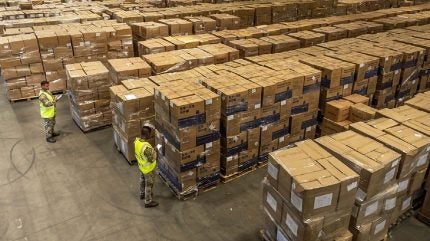
The global defence industry is responding to supply chains that were shaken by the Covid-19 pandemic, and now by the growing geopolitical uncertainty playing out in theatres around the world such as the war in Ukraine and the grey zone exchange across the Indo-Pacific.
On top of all this defence organisations are beset by their own internal problems, particularly the use of legacy technology and their siloed mode of operating with innovative suppliers.
In an exclusive interview, Stephen Carter, procurement practitioner, military historian and director of product at Ivalua – a spend management technology firm – explores how these hurdles can hamper supply chain visibility, overlook innovation and fail to leverage emerging technologies.

John Hill (JH): Could you map out the problem that defence companies face with their supply chains?
Stephen Carter (SC): Typically within a defence organisation, in certain tiers of it, they will be across different silos. So you would have one set of teams working on sourcing, another team working on contracts, one on procurement, purchasing, another team working on invoicing, and then another team working on payment, and they are totally disconnected.
There’s no visibility of that. The one common stakeholder in this is the supplier, and the supplier has to work with all those different teams. All those teams need to see the potential risk of that supplier and the opportunity that that supplier offers.
When you work in silos you don’t have a shared view of that supply chain. Therefore risk creeps into the process; it could be a supplier going bankrupt, or that supplier has a challenge with certain items or there’s a shared supplier or even a supplier that is flagged as high risk. Everybody in that chain needs to know that instantly. Also, when you have legacy technology there isn’t that visibility.
JH: Where does digitalisation come into this? How can digital technology help an organisation manage its supply chain more efficiently?
SC: Digitalisation is not just simply putting a process, product or solution in place, it’s also looking at the overall outcome your organisation is looking for.
So if we look at the digital procurement journey the UK MoD [Ministry of Defence] want to go on, they’ve got a vision and they need to go, “Okay, what technology is going to help us deliver that vision?” But at the same time, we need to make sure that when we’re implementing technology to support that vision it’s not going to sidetrack us.
At the same time, it’s not the only thing. There’s also keeping the staff on board, training the staff, and making sure that you’re doing exactly the same thing with your digital technology as you are doing with your procurement process.
“Technology supports a process and digital technology accelerates it.”
Stephen Carter, director of product, Ivalua
The power of digital is the instant piece, and by that I mean the ability to see instantly what’s going to happen, using technology like generative AI [artificial intelligence] to look at what could happen in the future, or to track what’s going on right now. It will quickly identify risks and challenges inside things like contracts.
Technology supports a process and digital technology accelerates it. But it’s no good unless the whole organisation is also thinking with a digital mindset.
JH: With demand across the global defence industry for greater innovation, how can organisations successfully cultivate it?
SC: From a supplier perspective looking in, you’re there to deliver the best value, but also looking for innovation, and innovation isn’t a gold-plated bit of technology. Innovation is: “We’ve got this new thing and we think it can improve this for the soldier on the ground in the field that we think we can help them”. That innovation comes from the suppliers and supply chains.
Then the defence sector will pick it up and they will evolve it, and I think that’s really where their buzzy word around spiral development comes in.
I think, over the past 20 years, it’s almost become so focused on cost-saving that the [industry has] almost forgotten its innovation path. That’s been hidden inside the silos of the business.
JH: A few months ago the UK MoD launched its policy of spiral development. How will this impact the issue defence organisations have with their legacy technology?
SC: The pragmatic approach to it is you don’t go with gold-plated, you take the first opportunity, and you then field test it, and you improve on it.
Now that has a massive impact on procurement and any organisation that’s got legacy technologies, because the organisation needs to be very agile with how it’s working with those suppliers, and they need to have a total loop.
If you’ve got a procurement team that are buying stuff, and then they’re writing into contracts that over the lifetime of this contract, we’re going to look at innovation, we can look at how that’s improved, we’re going to expect this level of detail on the contracts. We’re gonna put milestones in the contract indicating the annual, your first phase is now and then we’re going to expect you’re on field trials expect this change to be made.
I can safely say that if you do not have the finance team looking at the same contract and holding back the payment – because of payment regulations in the UK, you need to pay your suppliers within 30 days – you’ll just pay the invoice regardless of the quality that’s been delivered.
So you have to have everybody in that spending cycle with total visibility of this. If you look at spiral development from a siloed approach, then the organisation is not going to be agile enough to adopt that and make those changes.
One of the ways that procurements always get around that problem is by de-risking the process, so you invest in that smaller supplier in a proof-of-concept style.
The second way you de-risk is if it’s more of a commodity item, where you might be looking at a number of different designs or different materials from different manufacturers, you then have a more open framework so you can put an order out with three or four suppliers that can deliver the same thing, you de-risk it in the same way. Then, you can then do a proper quality evaluation of which one is best fit for purpose.



